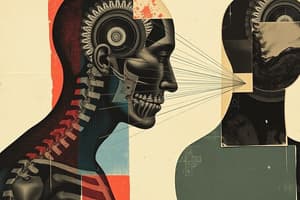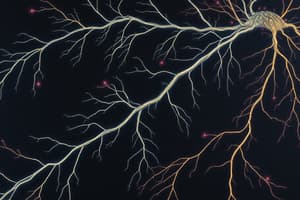Podcast
Questions and Answers
Motor skills can be disrupted by consciously thinking about them.
Motor skills can be disrupted by consciously thinking about them.
True (A)
The Dorsolateral Prefrontal Cortex is less active during new motor sequences.
The Dorsolateral Prefrontal Cortex is less active during new motor sequences.
False (B)
Neuroplasticity involves changes that occur only at the cortical level during sensorimotor learning.
Neuroplasticity involves changes that occur only at the cortical level during sensorimotor learning.
False (B)
The Supplementary Motor Cortex is associated with well-practiced motor sequences.
The Supplementary Motor Cortex is associated with well-practiced motor sequences.
Bridging severed spinal tracts is a focus in technologies aimed at overcoming spinal injuries.
Bridging severed spinal tracts is a focus in technologies aimed at overcoming spinal injuries.
Central sensorimotor programs can develop without any prior practice.
Central sensorimotor programs can develop without any prior practice.
Motor equivalence indicates that the same task can only be performed by the same set of muscles.
Motor equivalence indicates that the same task can only be performed by the same set of muscles.
Walking involves the integration of visual, somatosensory, and vestibular information.
Walking involves the integration of visual, somatosensory, and vestibular information.
Higher level oversight is essential for the execution of complex movements according to the Central Sensorimotor Program Theory.
Higher level oversight is essential for the execution of complex movements according to the Central Sensorimotor Program Theory.
Cats with transected spinal cords are unable to walk on a treadmill without assistance.
Cats with transected spinal cords are unable to walk on a treadmill without assistance.
Sensory information used by central sensorimotor programs is always processed consciously.
Sensory information used by central sensorimotor programs is always processed consciously.
Practice has no significant impact on the efficiency of central sensorimotor programs.
Practice has no significant impact on the efficiency of central sensorimotor programs.
The response-chunking hypothesis suggests that practice can group responses into larger integrated actions.
The response-chunking hypothesis suggests that practice can group responses into larger integrated actions.
Motor units consist of a single motor neuron and all the muscle fibers it innervates.
Motor units consist of a single motor neuron and all the muscle fibers it innervates.
Fast muscle fibers are highly vascularized and have high endurance.
Fast muscle fibers are highly vascularized and have high endurance.
Antagonistic muscles primarily produce the same movement.
Antagonistic muscles primarily produce the same movement.
Golgi Tendon Organs are located in the muscles and respond to changes in muscle length.
Golgi Tendon Organs are located in the muscles and respond to changes in muscle length.
The stretch reflex is a monosynaptic response that adjusts muscle tension.
The stretch reflex is a monosynaptic response that adjusts muscle tension.
Recurrent collateral inhibition helps distribute workload across a motor pool.
Recurrent collateral inhibition helps distribute workload across a motor pool.
Withdrawal reflexes take approximately 1.6 seconds to initiate.
Withdrawal reflexes take approximately 1.6 seconds to initiate.
Intrafusal motor neurons adjust the length of extrafusal fibers.
Intrafusal motor neurons adjust the length of extrafusal fibers.
Flashcards
Motor Unit
Motor Unit
A single motor neuron and all the muscle fibers it controls.
Motor Pool
Motor Pool
All the motor neurons that innervate a single muscle.
Neuromuscular Junction
Neuromuscular Junction
The junction between a neuron and a muscle fiber, where acetylcholine is released.
Synergistic Muscles
Synergistic Muscles
Signup and view all the flashcards
Antagonistic Muscles
Antagonistic Muscles
Signup and view all the flashcards
Stretch Reflex
Stretch Reflex
Signup and view all the flashcards
Withdrawal Reflex
Withdrawal Reflex
Signup and view all the flashcards
Recurrent Collateral Inhibition
Recurrent Collateral Inhibition
Signup and view all the flashcards
Conscious Interference in Motor Skills
Conscious Interference in Motor Skills
Signup and view all the flashcards
Dorsolateral Prefrontal Cortex (dlPFC) Role in Motor Learning
Dorsolateral Prefrontal Cortex (dlPFC) Role in Motor Learning
Signup and view all the flashcards
Premotor Cortex Role in Motor Learning
Premotor Cortex Role in Motor Learning
Signup and view all the flashcards
Supplementary Motor Cortex (SMC) Role in Motor Learning
Supplementary Motor Cortex (SMC) Role in Motor Learning
Signup and view all the flashcards
Neuroplasticity in Motor Learning
Neuroplasticity in Motor Learning
Signup and view all the flashcards
Recurrent Inhibition
Recurrent Inhibition
Signup and view all the flashcards
Walking
Walking
Signup and view all the flashcards
Central Sensorimotor Program Theory
Central Sensorimotor Program Theory
Signup and view all the flashcards
Motor Equivalence
Motor Equivalence
Signup and view all the flashcards
Unconscious Sensory Input
Unconscious Sensory Input
Signup and view all the flashcards
Fixed Action Patterns
Fixed Action Patterns
Signup and view all the flashcards
Practice and Central Sensorimotor Programs
Practice and Central Sensorimotor Programs
Signup and view all the flashcards
Response-Chunking Hypothesis
Response-Chunking Hypothesis
Signup and view all the flashcards
Study Notes
Spinal Motor Control
- Spinal motor control manages much of our motor output, using simple circuits between receptors, the spinal cord, and muscles.
- The brain isn't always needed for simple movements: these are fast and reliable.
Muscles
- Motor Unit: A single motor neuron and all the individual skeletal muscle fibers it innervates.
- Motor Pool: All motor neurons innervating a specific muscle.
Neuromuscular Junctions
- Acetylcholine is the neurotransmitter used at the neuromuscular junction.
- Acetylcholinesterase rapidly breaks down acetylcholine, closing channels.
- Motor end-plate: the receptive area on the muscle fibre at the neuromuscular junction.
Muscles (cont.)
- Muscles are attached to bones by tendons.
- Fast muscle fibers are forceful but fatigue quickly; they are poorly vascularized.
- Slow muscle fibers are weaker but highly enduring; they are well-vascularized.
Flexors & Extensors
- Synergistic muscles work together to produce the same movement.
- Antagonistic muscles produce opposite movements.
- Isometric contractions increase muscle tension without movement.
Receptors in Tendons & Muscles
- Golgi Tendon Organs: Embedded in tendons, they respond to muscle tension and help prevent over-contraction.
- Muscle Spindles: Embedded in muscles, they respond to changes in muscle length and provide proprioception.
Extrafusal & Intrafusal Muscle
- Intrafusal motor neurons adjust the length of intrafusal muscles, maintaining appropriate tension on muscle spindles. Without these neurons, spindles would be unresponsive to stretch during muscle contraction.
The Stretch Reflex
- The stretch reflex adjusts muscle tension in response to external forces.
- Intrafusal motor neurons adjust the length of intrafusal fibers.
- The reflex is monosynaptic (fast).
Muscle-Spindle Feedback System
- Unexpected forces trigger increased firing in spindle afferent neurons.
- This in turn increases firing in biceps motor neurons, maintaining the arm's original position.
Withdrawal Reflex
- Sensory neurons carry pain signals to interneurons on flexors initiating withdrawal in 1.6 ms.
- The withdrawal reflex happens before the brain receives the signal.
- Reciprocal innervation: when one muscle contracts, its antagonist relaxes.
- Inhibitory interneurons mediate this relaxation.
- Co-contraction helps with smooth movement.
Recurrent Collateral Inhibition
- Function: to distribute workload across motor pools.
- Process: An axon collateral excites Renshaw cells (inhibitory interneurons) in the ventral horn.
- Inhibiting the motor neuron that activated it.
- Reinforcement of rest after motor firing..
Walking: A Complex Sensorimotor Reflex
- Walking relies on visual, somatosensory, and vestibular information.
- It involves integrated movements of the trunk, legs, feet, and arms.
- The walking program is plastic, adapting to changing terrain and forces.
Central Sensorimotor Program Theory
- Lower levels of the sensorimotor system contain programmed activities.
- Complex movements activate a combination of these commands.
- Execution does not require higher-level oversight..
- Sensorimotor programs are not concerned with details only the goal.
Characteristics of Central Sensorimotor Programs
- Motor equivalence: one task can be achieved with different muscles or same muscles in different ways.
- Central sensorimotor programs use different muscles or body parts to achieve the same task.
- Control is high in the system.
Characteristics of Central Sensorimotor Programs (cont.)
Sensory information for controlling sensorimotor programs may not need to be conscious.
- Finger position when picking up objects is consistent with their actual sizes.
- not with the sizes we perceive them.
Characteristics of Central Sensorimotor Programs (cont.)
- Species-typical behavior may develop without practice.
- Fixed action patterns are a complete, instinctive behavioral sequence.
Characteristics of Central Sensorimotor Programs (cont.)
- Practice can create or refine central sensorimotor programs.
- Transferring control to lower levels frees up higher areas.
- Increased speed in tasks is achieved when lower levels process information simultaneously.
Characteristics of Central Sensorimotor Programs (cont.)
- Response chunking combines programs into larger units of programs.
- Smaller units such as key presses become chunks in typing and larger units like words and sentences arise out of key press chunks.
Characteristics of Central Sensorimotor Programs (Final)
- Acquired motor skills can be disrupted by conscious thought.
- Higher-level areas can interfere with well-established lower-level control mechanisms.
Functional Neuroimaging of Sensorimotor Learning
- Dorsolateral Prefrontal Cortex: active primarily during new motor sequences and conscious motor commands
- Premotor Cortex: plays a role in sensory-guided movements and new sequences
- Supplementary Motor Cortex: controls automatic movements and well-practiced motor sequences.
- Primary Somatosensory & Motor Cortices: active during both new and well-practiced motor sequences.
- Posterior Parietal Cortex & Cerebellum: active primarily during new motor sequences
Neuroplasticity and Sensorimotor Learning
- Sensorimotor learning changes in both cortical and subcortical levels
- Thalamic inputs and oligodendrocytes (supporting cells) in subcortical white matter increase during learning.
Bridging Spinal Injuries
- Spinal injuries can cause complete paralysis.
- Bridging severed spinal tracts is a focus of many new technologies.
Studying That Suits You
Use AI to generate personalized quizzes and flashcards to suit your learning preferences.



